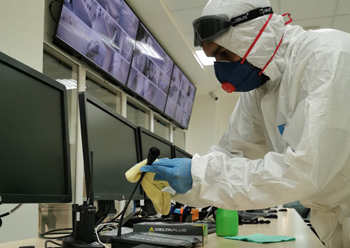Adapting to the new normal is key
A microscopic virus that has ravaged the world’s economy is calling for an urgent rethink of how we work, live and interact socially. Gulf Construction looks at the impact on the construction business and how buildings will need to adapt to the health challenges of the future.
01 July 2020
At the turn of the millennium, 9/11 shattered the US psyche and sent shockwaves throughout the world, which had huge repercussions on travel particularly due to highly tightened security. Less than two decades later, a pandemic is currently lashing out throughout the world, having already claimed half a million lives, cost the global economy billions of dollars, and millions of jobs, and created mental anguish on an alarming scale.
What is even more distressing is that the Covid-19 crisis will continue to have even more far-reaching effects on humanity, its mindset, lifestyle and its day-to-day operations. It will call for a transformation in social interactions, building design and layout and workstyles, and involve continued remote operations and increasing digitalisation.
In terms of construction output, growth for this year in the Middle East and North Africa (Mena) region has been revised to -2.2 per cent (down from -1.4 per cent previously) even as the sector expects further cuts mainly due to the impact of the novel coronavirus and low oil prices, according to Global Data.
 |
|
Companies are required to maintain enhanced hygiene standards. |
When businesses reopen and restrictions on movement are eased further during the third quarter, demand is expected to rebound only marginally and the recovery in spending will be contingent on confidence picking up, according to the data analytics and consulting company.
Surveys conducted in the region have revealed the gloom within the business community. A staggering 70 per cent of businesses in Dubai see a risk of closure within the next six months as the pandemic and global lockdowns ravage demand, a survey conducted between April 16 and April 22, by the Dubai Chamber of Commerce revealed.
Nearly three-quarters of those surveyed were small businesses with fewer than 20 employees. Of the respondents, more than two-thirds saw a moderate-to-high risk of going out of business.
A similar survey conducted by the Bahrain Chamber of Commerce and Industry (BCCI) revealed that business in the country have wide concerns over the economic implications of the ongoing Covid-19 pandemic with 55 per cent of the real estate and construction firms expecting closure in the next six months if things don’t improve. Around 1,180 companies, ranging from micro to large establishments in nearly a dozen sectors, were surveyed during the full and partial closure of business in the country to prevent the spread of the coronavirus.
The survey entitled ‘The Economic Impact of Coronavirus on Business Owners’ found that the tourism and hospitality industry would be the hardest hit with 71 per cent of businesses expecting closure over the next six months amid fears of significant layoffs if the pandemic continues. Among other sectors, 49 per cent of businesses in the industry and energy sector feared they would have to close shop.
Some 67 per cent businesses expect a significant decrease in revenue in the upcoming period, and 84 per cent of businesses expressed concerns regarding payment of salaries.
A promising sign is seen in the businesses’ hope for recovery. According to the survey, 77 per cent businesses expected to recover within 12 months after the pandemic ends.
 |
|
Social distancing is vital to keep infection levels down. |
To stem the crisis, the GCC countries have promptly rolled out several initiatives to support business operations and residents in the region and have attempted to flatten the curve through partial as well as total lockdowns while putting in place the basic infrastructure that is vital to tackle the onslaught of the highly virulent Covid-19 outbreak.
However, the pandemic is far from over and a vaccine is not yet in sight.
In the interim, convention centres have been transformed into test centres, schools and clubs premises used to accommodate workers who have been living in congested camps; and empty hotels remodelled to Covid hospitals. Companies have been required to adapt to new jobsite demands like social distancing, enhanced hygiene standards in the premises, making use of masks mandatory, provision of sanitisers and washing facilities, health checks and remote working where possible to proceed in their new normal.
As the pandemic caught everyone by surprise, most countries in the region allowed themselves three months to prepare to tackle the health challenge.
Now, deeming that it is time to restart the economy to prevent widespread bankruptcies, the governments in the region are relaxing the curfews that have been in place and with this has come the need to rethink how people work and how businesses and buildings operate, and strategies worked out to keep workers and patrons safe to curb the number of new infections.
Remote working wherever possible will continue to be the optimum way to keep businesses operational and safe. Video-conferencing will enable staff and client interaction, while webinars and virtual events will be the new normal during the pandemic and possibly well after a solution is found.
The pandemic has accelerated the development and adoption of digitalisation, with increased focus on the use of robots and automation, deployment of artificial intelligence and virtual reality to improve work processes, design, construction, and operations.
There is renewed interest in contactless access to and within buildings, antimicrobial surfaces and coatings, hygienic washroom solutions and in enhancing the indoor air quality and air-conditioning companies and organisations are pushing ahead to help the community gear up for the new normal.
The American Society of Heating, Refrigerating and Air-Conditioning Engineers (Ashrae), for instance, has created an Epidemic Task Force to help deploy its technical resources to address the challenges of the current pandemic and future epidemics in relation to the effects of heating, ventilation and air-conditioning (HVAC) systems on disease transmission in healthcare facilities, the workplace, home, public and recreational environments.
In April, it issued a position paper that provides recommendations for controlling infectious aerosols, which is how the novel coronavirus is transmitted (https://www.ashrae.org/technical-resources/resources).
Ventilation and filtration provided by HVAC systems can reduce the airborne concentration of SARS-CoV-2 (the novel coronavirus) and thus the risk of transmission through the air. Unconditioned spaces can cause thermal stress to people that may be directly life threatening and that may also lower resistance to infection. In general, disabling of these systems is not a recommended measure to reduce the transmission of the virus, it says.
This position document provides recommendations on the following:
- The design, installation, and operation of HVAC systems, including air-cleaning, and local exhaust ventilation (LEV) systems, to decrease the risk of infection transmission;
- Non-HVAC control strategies to decrease disease risk;
- Strategies to support facilities management for both everyday operation and emergencies.
Infectious diseases can be controlled by interrupting the transmission routes used by a pathogen, Ashrae says, adding that HVAC professionals play an important role in protecting building occupants by interrupting the indoor dissemination of infectious aerosols with HVAC and LEV systems.
In response to the issues that have surfaced during the current pandemic, HVAC experts will be under pressure to let in more fresh air into buildings and keep indoor relative humidity levels at between 40 and 60 per cent, according to current Ashrae guidelines.
Another key issue that governments will need to tackle is the reopening of schools in the region which would have been closed for well over eight months by the time they are scheduled to reopen in September.
The American Institute of Architects (AIA) has attempted to address this crucial issue in its reports ‘Reopening America: strategies for safer buildings’ and the latest ‘Reopening America: Strategies for Safer Schools’ (http://content.aia.org/sites/default/files/2020-06/Reopening_America__Strategies_for_Safer_Schools_June_2020.pdf).
In its report on schools, AIA states: “The steps that we take today in response to the Covid-19 pandemic will lay the groundwork for the proactive, long-term preparedness necessary to ensure our schools are resilient to future shocks and stresses, including potential influenza pandemics.
The AIA provides a seven-step risk management plan for buildings to assess hazards, prioritise and apply architectural or engineering strategies (controls), and reduce risk.
These include:
- Assembling the multidisciplinary team.
- Establishing goals and objectives for reducing risk.
- Describing the building flow and user experience.
- Conducting the hazard analysis and characterise the potential risk.
- Identifying architectural or engineering controls for each hazard determined in terms of programming, space planning, non-structural partitions and openings, signage, plumbing and plumbing fixtures, mechanical and passive ventilation, electrical, lighting and communications, appliances, equipment and accessories, finishes and furnishings, site work, in addition to policies, procedures to reduce the spread of pathogens, physical distancing and PPE (personal protection equipment) policies.
- Verifying system hazard controls; and
- Validating system hazard controls.



